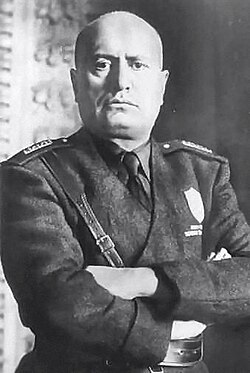This article needs additional citations for verification .(July 2008) |


The Axis powers of World War II was established with the signing of the Tripartite Pact in 1940 and pursued a strongly militarist and nationalist ideology; with a policy of anti-communism. During the early phase of the war, puppet governments were established in their occupied nations. When the war ended, many of them faced trials for war crimes. The chief leaders were Adolf Hitler of Nazi Germany, Benito Mussolini of the Kingdom of Italy, and Hirohito of the Empire of Japan. [1] [2] Unlike what happened with the Allies, there was never a joint meeting of the main Axis heads of government, although Mussolini and Hitler met on a regular basis.
Contents
- Bulgaria
- Germany
- Hungary
- Italy
- Japan
- Romania
- German client states and protectorates
- Slovak Republic
- French State
- Protectorate of Denmark
- German puppet states
- Province of Ljubljana
- Norwegian National government
- Government of National Salvation, Serbia
- Italian puppet states
- Albanian Kingdom
- Kingdom of Montenegro
- Joint German–Italian puppet states
- Hellenic State
- Independent State of Croatia
- Japanese puppet states
- State of Burma
- Kingdom of Cambodia
- Republic of China-Nanjing
- Provisional Government of Free India
- Kingdom of Laos
- Manchukuo
- Mengjiang
- Second Philippine Republic
- Empire of Vietnam
- Co-belligerents
- Finland
- Iraq
- Thailand
- References























